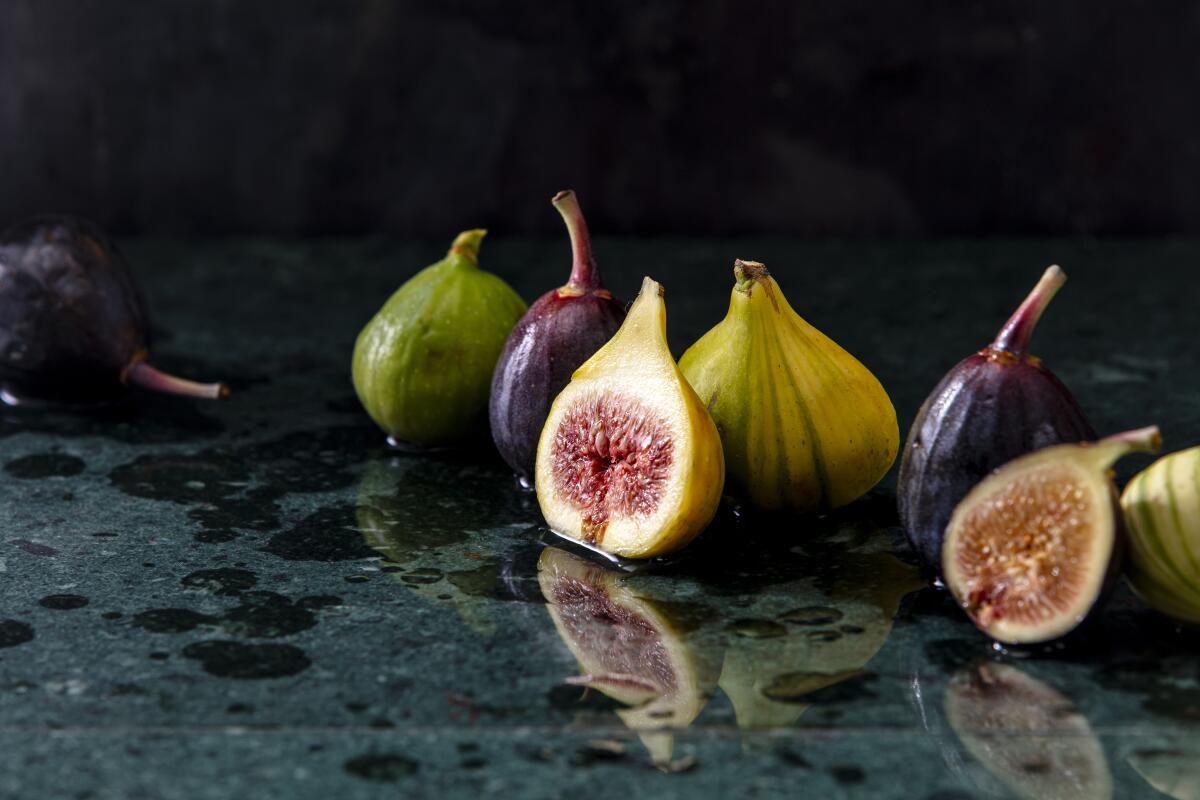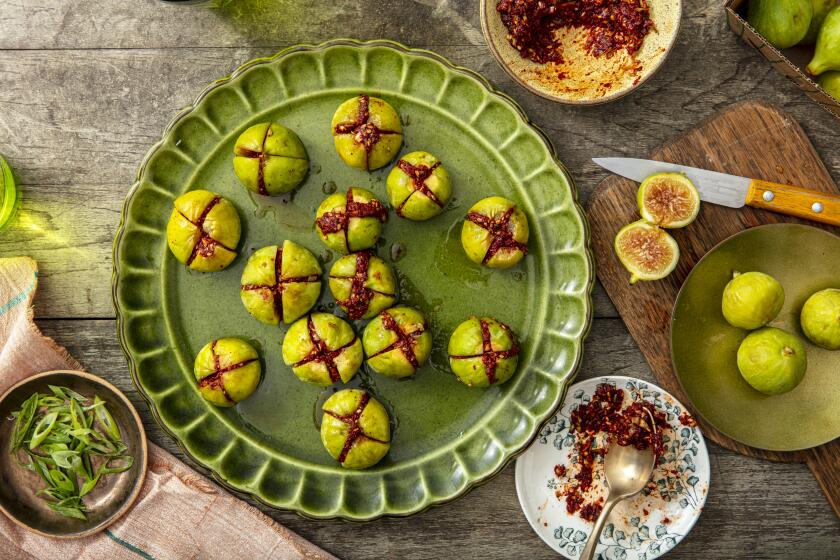Looking beyond the simple approach to figs

When it comes to fruit, I’m a meddler. I appreciate the beauty, simplicity and taste of a raw piece of fruit eaten out of hand, but as a pastry-prioritized person, I appreciate the skill of transforming it into a new dish to better balance what properties it brings to the table. Figs may be the fruit most representative of this viewpoint. While I understand both sides of the equally maligned and celebrated “figs on a plate” ethos of California cooking, it is, I hate to admit, not for me.
Figs are among my favorite fruits, ones I love eating during their fleeting season more than most any other. They may lack the mainstream pop of summer stone fruit, autumn apples or winter citrus, but they make up for it by possessing that unique between-seasons quality of heady, summer sweetness mixed with a deep, rich murkiness more apt for the approaching cold weather. So this year, I wanted to play around with their different personalities, to find fun, new ways to appreciate their multiplicity.
Figs are often paired with other fruit or used in sweet applications, but I wanted to see how they played in more overtly savory dishes beyond a salad of greens with goat cheese. Green varieties such as Tiger Stripe, Kadota or Calimyrna are delicious, but they’re often a little too intensely rich for me when ripe — like nature’s version of the frozen honey blobs popular on TikTok. Sometimes, though, you can get under-ripe specimens in your basket that taste only of barely sweetened water. This brought to mind pickling figs to see how they’d react in a tart, spiced brine. As it turns out, quite well.
I slice the figs equatorially to get beautiful, round cross sections and to expose more of their flesh to the brine. However, because figs are more delicate, a weaker brine is required than if you were pickling your usual cuke. I dilute white wine vinegar with a little water and sweeten it lightly with honey. Toasted and cracked fennel seeds and potent-but-not fiery Marash chile flakes add earthiness to mimic that of the green figs. These pickles are delicate enough to serve on their own or layer onto a prosciutto sandwich. You can also use their brine in a martini.
For the honey-bomb figs, I was a little more assertive. Their shape brought to mind the small trunks of cucumber used to make cucumber kimchi, so I adapted the mix of Korean chile flakes, fish sauce, scallions and ginger used for that and stuffed it into crosscut figs. After a few days collapsing under their own weight from being packed on top of each other in a container, they give off a savory chile syrup that coats the figs, while fish sauce and sesame seeds add a hit of umami that balances the intense sweetness. I spent a week tucking spoonfuls of the kimchi into plain rice, sometimes topped with steamed fish, and was delighted by how perfectly the delicate fruit stood up to the tenacious filling.
For purple fig varieties such as Black Missions or Turkish — my favorite — I opted to go the more traditionally sweet route but I used more lean ingredients to balance out their richness. In Kitty Travers’ “La Grotta Ices” cookbook, she makes a sorbet of figs mixed with watermelon, because the figs “give body and sap to the watery” melon. After making that recipe, I had slices of fig and watermelon on my board and found that eaten together as is, the combination worked just as well — the jammy, soft figs complementing the lean, crunchy melon — especially when tiled over ricotta spread on sesame toast I had nearby as a snack. A drizzle of tahini amplifies the sesame and, along with some grated lime zest, adds a touch of needed bitterness and florality. It’s now become my go-to breakfast during this brief window of the fruit year.

For a full-on dessert, I wasn’t content with just tossing fruit in a cake batter or pastry dough for a galette (see aforementioned meddling). Instead, I wanted to take it back, aaallll the way back, to my first memories of eating figs as a child — in a Fig Newton. Apparently, Nabisco knows a thing or two about balancing the intense sweetness of figs with a whole-wheat cookie dough and how brilliant that pairing is. But instead of trying to re-create the cookie, I wanted a more elegant but simple layer cake to show off the fruit in two ways.
The first is in a honey-sweetened quick jam that brings out the deep pruniness of the figs, a perfect foil for a tender cake made with rye flour that sandwiches that chunky jam. The second is by adding lemon juice to some of the jam and pureeing it into a tart sauce to top the cake. I swath the cake in a browned butter frosting — its nuttiness complementing the rye flour in the cake and the honey in the figs — then pour over the fig sauce, which has turned a shade lighter and pinker than its jammy sister in the cake. Perfectly balanced, it’s the type of cake that somehow works well as dessert, teatime snack and breakfast all at once. And despite the hearty rye flour and browned butter, the figs aren’t dulled at all; in fact, they shine through more brightly.
Through this meddling, I happily landed on some recipes that highlight the fig’s versatility. Not just a sweet, soft fruit to be enjoyed on its own, it can also take on stronger flavors and more tinkering with than we give it credit for. A plate of figs is just the starting point.
Get the recipes:
Fig and Watermelon Toast With Ricotta, Sesame and Lime
Quick Green Fig Kimchi
Pickled Figs With Marash Chile and Fennel Seeds
Honeyed Fig and Rye Cake With Brown Butter Frosting
More to Read
Eat your way across L.A.
Get our weekly Tasting Notes newsletter for reviews, news and more.
You may occasionally receive promotional content from the Los Angeles Times.















